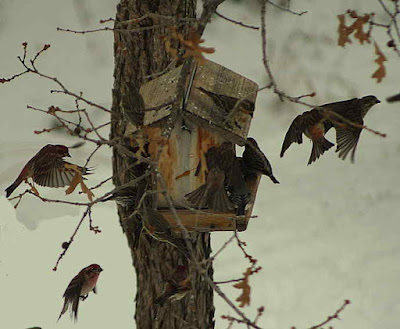

Hanging out the laundry, M. noticed a collective twittering of nuthatches high up in a pine tree--and one larger bird sitting still.
Last year, on a sunny afternoon in late January,
we swore we had seen a northern hawk owl, which if true would mean that it was way south of its normal range.
That time, we had a good look through binoculars and consulted field guides--but we did not have a camera with long lens ready. And then it flew away, having consumed the junco it had snatched near one of the bird feeders.
As
Project Feeder Watch participants, we reported it to the Cornell ornithology lab. The response was polite but non-committal: Your report is sounds intriguing, but we would really like to see a photo. And we had no photo. So we did not rock the ornithological world.
This time, I had the new Pentax K100D digital camera and a so-so 500mm mirror lens, and I shot several pictures from the porch before the bird flew off.
After downloading and sharpening them a little in
Graphic Converter (the poor man's PhotoShop), I realize that I was looking at . . . a
sharp-shinned hawk. [No, see updates below.]
It was eating a pygmy nuthatch while being mobbed by other pygmy and white-breasted nuthatches--but being mobbed by nuthatches is not too scary if you're
a hawk an owl.
Of course now we are wondering about our alleged
hawk owl. Were we acting like newbies, getting all excited over an exotic species? Did our years of counting owls for the BLM make us too ready to see an owl rather than a hawk? Or was it really the hawk owl? If it was, I wish it would come back.
At least digital photography offers instant gratification. I do not plan to give
SeEtta Moss any serious competition, however.
UPDATE: Steve Bodio votes for a pygmy owl. I was puzzled at the time by the slightly stocky body shape the bird presented, but I put that down to cold weather (feathers puffed) and to the fact that it was hunching over its prey.
UPDATE 2: SeEtta Moss (see comments) agrees that it is a pygmy owl, so I have changed the headline.
 Next Saturday is Eagle Day at Pueblo Reservoir, an unpredictable festival that depends on the vagaries of birds and weather.
Next Saturday is Eagle Day at Pueblo Reservoir, an unpredictable festival that depends on the vagaries of birds and weather. Clark's nutcracker tackles the suet-cake feeder.
Clark's nutcracker tackles the suet-cake feeder. Clark's nutcracker, showing its long bill
Clark's nutcracker, showing its long bill Cassin's and house finches mob the sunflower-seed feeder.
Cassin's and house finches mob the sunflower-seed feeder.
 Hanging out the laundry, M. noticed a collective twittering of nuthatches high up in a pine tree--and one larger bird sitting still.
Hanging out the laundry, M. noticed a collective twittering of nuthatches high up in a pine tree--and one larger bird sitting still.